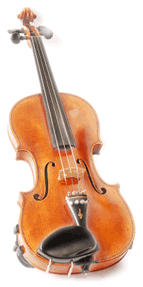|
Violin
Suggested
Range
About Our
Suggested
Ranges
|
 General Information General Information
Simply put, an orchestra just doesn't sound like an orchestra
without the violin section. This
section most often plays the melody because the violins
can make our hearts soar, make us shed a tear or tickle our funny bone.
When other instruments do play the melody, the violins
often play counter melodies, background harmonies or ornamental embellishments.
They can alternate between these functions seamlessly and in the blink
of an eye.
Tuning
Like the other bowed stringed instruments in an orchestra
(i.e., the viola, cello and bass),
the violin has four strings. The
lowest sounding string is the G string. This string plays the G just
below middle C and represents the lowest note of the violin range.
The next string is the D string. This is the D just above middle C.
The string above that is the A string, and the final string is the
E string.

If you play the string as is, without placing your finger
on it, you are playing an open string. Just like a guitar,
if you place a finger from your left hand on the string, it raises the
pitch of the note.
|
|